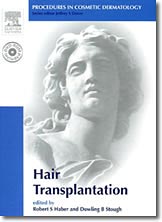 Surgery of the Skin: Procedural Dermatology; published in 2005 by Elsevier-Mosby and Edited by Robinson, Hanke, Sengelmann and Siegel; is monumental work that covers the entire spectrum of dermatologic surgical procedures. In the editor’s words, the goal of this 872 page textbook is:
Surgery of the Skin: Procedural Dermatology; published in 2005 by Elsevier-Mosby and Edited by Robinson, Hanke, Sengelmann and Siegel; is monumental work that covers the entire spectrum of dermatologic surgical procedures. In the editor’s words, the goal of this 872 page textbook is:
“To capture the art and practice of dermatologic surgery at the beginning of this century.”
It is to be used as the core surgical textbook for dermatologic training programs. The book is divided into four parts: Part I – Basic Surgical Concepts, Part II – Essential Surgical Skills, III – Aesthetic Surgical Procedures, and IV – Special Procedures.
The text covers a wide range of subjects on aesthetic surgery, including liposuction, chemical peels, Botox, soft tissue augmentation, laser hair removal, laser skin resurfacing, leg vein treatment, blepharoplasty, face lifts and, of course, hair transplantation.
Dr. Bernstein was honored to write the section on hair transplantation that covers the historical aspects of the field, patient evaluation and surgical planning, operating room set-up, surgical techniques and how to maximize the cosmetic outcome of the hair transplant.
The focus of Dr. Bernstein’s chapter is on Follicular Unit Transplantation, the technique that has changed the face of surgical hair restoration over the past decade. The chapter discusses strip harvesting, follicular unit extraction, the use of anesthetics, ways to optimize density and ensure the naturalness of the procedure, as well as a host of other important topics. The textbook may be purchased at Amazon.com.
Posted by

 “Hair Transplantation” is one in a series of medical textbooks published by Elsevier Saunders. The textbook — part of a series entitled Procedures in Cosmetic Dermatology — is written by Robert S Haber and Dowling B. Stough and edited by Jeffrey S. Dover. “Hair Transplantation” offers a step-by-step, practical guide to performing cutaneous surgical procedures.
“Hair Transplantation” is one in a series of medical textbooks published by Elsevier Saunders. The textbook — part of a series entitled Procedures in Cosmetic Dermatology — is written by Robert S Haber and Dowling B. Stough and edited by Jeffrey S. Dover. “Hair Transplantation” offers a step-by-step, practical guide to performing cutaneous surgical procedures.


